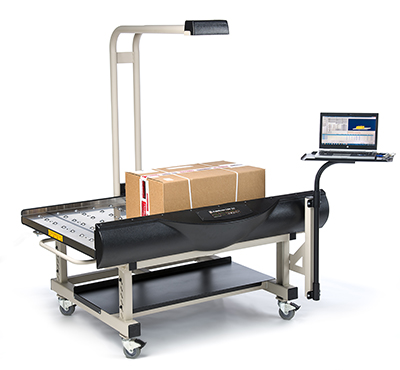Economic recovery and the rise of e-commerce sales have driven up demand for industrial real estate as businesses look to make investments in warehouses to support expanding operations. This shift places tremendous pressure on organizations to enhance operational efficiencies, as it relates to handling large product volumes, in order to trim costs and thereby generate higher savings and revenues. Dimensioning solutions, also known as cubing solutions, are data capture devices that enable data capture and cubing of objects and items. They have gained in popularity in the US distribution and warehousing space since 2015 as major third-party logistics service providers (3PLs) as FedEx, UPS, and DHL transitioned to new dimensional weight-based pricing models from their more traditional weight-based models.
VDC's research indicates that e-commerce sales growth has resulted in an overall increase of not only warehouse throughput but also the number of SKUs for which each individual DC is now responsible. Recent reseller conversations highlight that rising costs associated with leasing and buying warehouse locations are a major driver for businesses to invest in dimensioning solutions in order to better utilize available space. Our research also shows that the need to enhance supply chain efficiencies, optimization asset availability and storage, and avoid chargebacks that arise due to errors in dimensional measurement are just some of the leading needs that will drive dimensioning solutions adoption going forward.
Dimensioning solutions are available in four major form factors: handheld (mobile solutions), in-motion, pallet, and static. These deploy a range of non-contact sensing technologies including, but not limited to, cameras, infrared light, laser, and ultrasound in order to capture accurate dimensional information for packages in a variety of shapes, sizes, colors, and materials. According to VDC's recently concluded research on the topic, the most popular form factor is in-motion, built to handle a broad range of items in high volumes; infrared technology takes top spot as the one with the largest installed base. Leading dimensioning solution vendors include CubiScan, Datalogic, Mettler Toledo, Postea, and SICK. Each vendor offers its own unique set of form factors using various underlying dimensioning technologies.
In the table below, VDC outlines the various types of dimensioning systems available in the industrial marketplace today:
|
Form Factor |
Description |
|
Static |
Small to medium sized fixed dimensioning/cubing solutions, which measure static objects; typically placed on workstations, desks, or mobile carts. Designed for low volume scanning and commonly deploy one type of technology for dimensional data capture.
Examples – Mettler Toledo CSN810 TableTop, SICK ICR88x System |
|
In-motion (also known as In-line) |
Integrated/conveyorized dimensioning solutions that capture dimensional data of objects in-motion. These enable high-volume dimensioning of parcels, irregularly shaped products, and non-cuboidal objects. Multiple sensor technologies used simultaneously to capture and calculate dimensional data.
Examples – Datalogic DM3610, QubeVu Industrial, VITRONIC Vipac D1 |
|
Pallet |
Large fixed solutions that are used to measure static pallet loads, non-cuboidal/irregular shaped items, and multi-piece shipments. Solutions mounted onto a ceiling, wall, or floor depending on the model. Multiple sensor technologies deployed to capture dimensional data of large items.
Examples – CubiScan 1200 AKL, SICK DWS Pallet |
|
Handheld (mobile dimensioning) |
Portable solutions include mobile computers with integrated special cameras or software development kits that enable consumer-grade smart devices to use their built-in cameras for enterprise-grade product dimensioning. Used to provide dimensional guidance for both large and small items.
Examples – MobileDemand xTablet T8650 |
End Users Sizing up Dimensioning Investments
VDC surveyed 112 end-user enterprises regarding their existing investments in dimensioning hardware to meet their specific application requirements. Competitive differentiation, optimizing storage, compliance with dimension-based (DIM) pricing, optimizing available assets, and order fulfillment are the key drivers for dimensioning solution investments per our respondent base.
Here are some of the other research highlights:
- Common outbound processes like truck/trailer load optimization, delivery planning, and shipping manifestation are not the only reasons for organizational investments in dimensioning solutions.
- 67% of installed solutions today support inbound workflows to maximize operational efficiency and optimize storage capabilities by dimensioning items as they enter.
- 57% of items shipped by organizations are cubical in shape including, but not limited to, corrugated boxes, mail/letters, pallets/large freight, and parcels.
- Irregular shaped items accounting for the remaining 43% include polybags, burlap/cloth, backpack/bags, luggage, and even items that cannot fit into a container and ship without packaging.
- Primary issues faced with dimensioning solutions include inability to accurately measure irregular shapes (65%), slow dimensioning speeds (52%), scanning errors due to color/shape (44%), and hardware integration challenges (34%).
VDC's View—Cost-Effective Dimensioning Will Drive Interest
According to VDC, dimensioning and weighing solutions can provide numerous benefits such as eliminating chargebacks, load planning, managing freight costs, and maximizing storage space. For shipping, dimensioning solutions enable organizations to optimize asset utilization by packing existing fleet of trucks and vehicles efficiently to transport more products. In the warehouse and DC, these solutions can help organizations optimize their load planning processes, carry out damage checks, enhance the inbound receiving process, and make best use of available storage space for inventory and stocking. That said, project costs and complexity are significant barriers for adoption.
End user organizations will continue to operate without making investments in dimensioning solutions so long as chargebacks and the costs associated with inefficient stocking practices are not significant enough to drive interest. Introduction of and investments in handheld/mobile dimensioning devices could prove to be a turning point at least from an awareness standpoint given the relatively lower device acquisition costs. Additionally, software platforms that enable the use of consumer smart devices (with built-in cameras) for dimensioning applications will also expand the total available and addressable market for these solutions. VDC believes that positioning these solutions, as a cost-effective investment option will also open up opportunities in packaging optimization, as will regulatory considerations for dimensioning and weighing. Dimensioning and measuring systems certainly have the potential to become integral to organizational operations in the industrial supply chain as these highlight their ability to accurately capture valuable data, increase storage density, and improve overall efficiencies. For more information on VDC's Dimensioning Solutions Market Report, click here.
About VDC Research
Founded in 1971, VDC Research provides in-depth insights to technology vendors, end users, and investors across the globe. As a market research and consulting firm, VDC's coverage of AutoID, enterprise mobility, industrial automation, and IoT and embedded technologies is among the most advanced in the industry, helping our clients make critical decisions with confidence.

Richa Gupta is VDV Research's director of AutoID & Data Capture. She can be reached by email at [email protected]. Click here to read VDC's latest research into the global market for mobile thermal printers.
SC
MR


Latest Supply Chain News
- How CPG brands can deliver on supplier diversity promises
- How S&OP provides the answer to in-demand products
- AI, virtual reality is bringing experiential learning into the modern age
- Humanoid robots’ place in an intralogistics smart robot strategy
- Tips for CIOs to overcome technology talent acquisition troubles
- More News
Latest Podcast

 Explore
Explore
Topics
Software & Technology News
- AI, virtual reality is bringing experiential learning into the modern age
- Humanoid robots’ place in an intralogistics smart robot strategy
- Tips for CIOs to overcome technology talent acquisition troubles
- Game on: Rethinking change management for the digital era
- Predicting stockouts: Enhancing FMCG resilience through data-driven insights
- Top Performers Investing in, Benefitting from AI
- More Software & Technology
Latest Software & Technology Resources

Subscribe

Supply Chain Management Review delivers the best industry content.

Editors’ Picks





